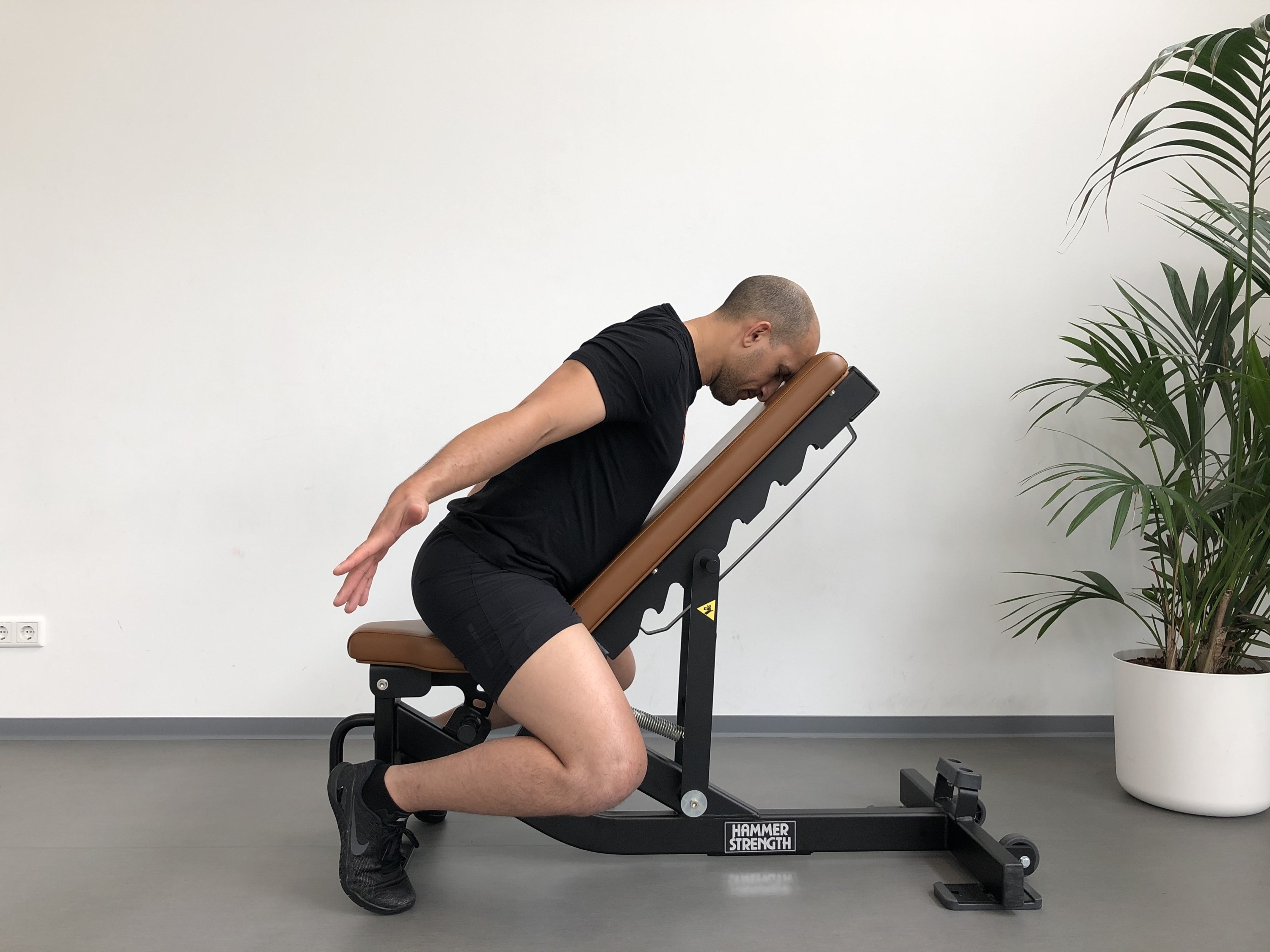
Shoulder blade (Scapular dyskinesis)
When you have problems with your shoulder, the cause may be the shoulder blade. This injury is commonly seen in people that lift above shoulder height, sitting/standing in one position for a long time and lifting heavy. Issues with the positioning of the shoulder blade can cause shoulder pain and restrict shoulder movement. Find here all information and matching exercises.
Phase 1 of recovery
During this phase, the goal is to reduce pain, improve coordination and activate the shoulder muscles.
1. Rekoefening (schouder retractie)
Rekoefening (schouder retractie), ga op de knieën zitten (of stoel). Plaats de handen gevouwen achter de rug en neem een actieve houding aan. Breng de schouders naar achter, de schouderbladen bewegen naar elkaar toe. Blijf in deze houding voor minimaal 30 sec.
2. Anteflexie schouder
Ga recht op de stoel zitten, pak de stok vervolgens met beide handen vast op schouderbreedte. Houd de stok boven de benen en breng deze vervolgens met gestrekte armen tot boven je hoofd. Vervolgens breng je de stok met gestrekte armen terug naar de beginpositie.
3. Low row
Kom rechtop staan, plaats één been voor, breng de schouders richting de broekzak, trek de schouderbladen licht naar elkaar toe, zet de armen in de zij en trek het elastiek met gebogen armen naar achteren. Breng de armen terug naar voren en herhaal deze beweging.
4. Scapular straight arms
Kom rechtop staan, pak het elastiek vast in beide handen, draai de armen naar binnen, breng de schouders richting de broekzak, trek de schouderbladen licht naar elkaar toe, trek het elastiek vervolgens met gestrekte armen naar achteren toe. Breng de armen terug naar voren en herhaal deze beweging.
5. Row 1 arm in stand
Zorg dat je met beide handen een uiteinde van de elastiek vast hebt. Zak vervolgens licht door de knieën, behoudt een rechte rug en houd je ellebogen langs je lichaam. Trek vervolgens arm voor arm het elastiek naar achteren. Houd je ellebogen constant langs je lichaam. Herhaal dit.
6. Retractie in buiklig
Ga op je buik liggen, maak een vuist of pak in beide handen één gewichtje, ontspan het hoofd, breng de schouders omlaag, breng de schouderbladen licht naar elkaar toe en herhaal deze beweging.
7. Retractie in ABER positie
Ga op je buik liggen, ontspan het hoofd, breng de handen naast de oren, breng de schouderbladen vervolgens licht naar elkaar toe en vervolgens weer terug, herhaal deze beweging.
8. VW oefening
Ga op je buik liggen. Strek de armen schuin omhoog langs het hoofd uit (V). Breng ze vervolgens weer terug naar beneden en breng ze richting de zij (W).
Phase 2 of recovery
During this phase, the goal is to strengthen the shoulder muscles
1. WYL
Ga op beide benen staan, pak in beide handen het elastiek vast, maak eerst de letter (W) door de ellebogen in de zij te plaatsen en de handen naar buiten te draaien, strek vervolgens de armen uit boven het hoofd (Y), tot slot maak je twee haakjes van 90 graden in de ellebogen (L).
2. Dumbell single arm row
Ga met je knie op een bankje zitten, plaats de hand op het bankje, pak in de andere hand een gewicht, houd de rug recht, breng het gewicht naar beneden, houd de rug daarbij recht, trek het gewicht vervolgens via de zij terug omhoog.
3. Row in stand TRX
Pak met beide handen de handvatten van de TRX. Zorg dat je deze voor je houdt en houd je armen licht gestrekt. Trek vervolgens je borst naar je handen en houd je ellebogen langs je lichaam. Zak vervolgens weer langzaam terug naar beginpositie, Herhaal dit.
4. Buiklig superman diagonaal
Buiklig superman diagonaal, ga in buiklig op de grond liggen en strek je armen voor je uit. beweeg vervolgens je linkerarm omhoog en tegelijkertijd je rechterbeen. Ga terug naar de beginpositie en herhaal nu de beweging aan de andere kant.
Resistance band
Hard. Compact. Qualitatively.

Dumbell
Hard. Compact. Qualitatively.

The meaning of shoulder blade injuries?
Issues with the positioning of the shoulder blade can cause shoulder pain and restrict shoulder movement. We used to think that any deviation of the shoulder blade compared with the other side (scapular dyskinesis) needed to be addressed to resolve the shoulder pain. Recent studies have shown this is erroneous. There are many factors that play a role in determining if the altered positioning of the shoulder blade is the cause of, or a risk factor to, developing shoulder pain.
The causes of shoulder blade injuries
An altered shoulder blade position can influence shoulder function. Shoulder mobility (gleno-humeral joint), the subacromial space and the activation pattern of shoulder muscles (neuromuscular activation pattern) can be affected. The exact cause is unknown and seems to be multifactorial (stress, fatigue, load, idiopathic, etc.).
The symptoms of shoulder blade injuries
The main symptom reported is pain at the front and side of the shoulder joint. The pain is often sharp in nature. The shoulder tends to ache after aggravating the shoulder by for instance lifting overhead, heavy lifting or sitting in the same position for a prolonged amount of time. Often symptoms diminish quickly with rest, only to return with increased loading of the shoulder.
The treatment of shoulder blade injuries
If the physiotherapist has indicated that the positioning of the shoulder blade is in part responsible for your shoulder pain, it is important to correct this with exercises. Recovery times range between 6 weeks and 6 months.
Phases of recovery
Phase 1 - static stability
Phase 2 - dynamic stability
Phase 3 - return to sport
Synonyms
Scapular dyskinesis, scapular glide, scapular winging, scapula sticking out, scapular movement pattern
Advice
If you have any questions regarding the exercises, doubt if you are doing them correctly or aren’t sure they are suited for your condition, please contact your physiotherapist for support.
Attention:
Yourbody.coach offers a range of exercises. Yourbody.coach can not be held responsible if you develop injuries. Always consult your physiotherapist or specialist.